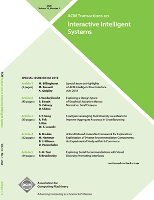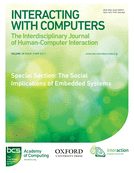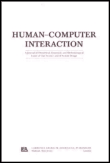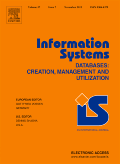
ACM Transactions on Interactive Intelligent Systems
Scope & Guideline
Unveiling Insights at the Crossroads of Technology and Humanity.
Introduction
Aims and Scopes
- Human-AI Collaboration:
The journal explores how humans and AI can work together effectively, focusing on trust, transparency, and the dynamics of human-AI teams. - Explainable AI (XAI):
A significant emphasis is placed on developing AI systems that can explain their reasoning and decisions to users, enhancing trust and usability. - Interactive Data Visualization:
Research in this area focuses on improving how users interact with complex data through visual means, including explorations into user-centered design and analytics. - User Experience and Interaction Design:
The journal covers methodologies for designing interfaces that enhance user experience, particularly in the context of intelligent systems. - Ethics and Bias in AI:
TiiS addresses the ethical implications of AI technologies, including fairness, bias mitigation, and responsible AI use. - Adaptive and Personalized Systems:
Research often investigates how systems can adapt to individual user needs and preferences, improving the overall interaction experience. - Social and Emotional AI:
The journal explores the development of AI that can recognize and respond to human emotions and social cues, facilitating better interactions.
Trending and Emerging
- Trust and Transparency in AI Systems:
Recent publications emphasize understanding how users can trust AI systems, focusing on transparency and explainability as critical factors in user acceptance. - AI Ethics and Fairness:
There is a growing trend towards addressing ethical concerns related to AI, particularly focusing on bias mitigation and fairness in AI applications. - Natural Language Interfaces:
The popularity of natural language processing and conversational interfaces is increasing, with a focus on how they can facilitate better user interactions and data exploration. - Interactive Machine Learning:
Research on integrating user feedback into machine learning processes is trending, highlighting the importance of human input in refining AI models. - Visual Analytics and Data Interpretation:
Emerging themes include the development of tools and techniques for visualizing complex data, enhancing user understanding and decision-making through interactive analytics. - Personalization Techniques in Intelligent Systems:
An increased focus on adaptive systems that cater to individual user preferences and contexts is evident, reflecting the demand for more personalized interactions.
Declining or Waning
- Traditional User Interface Design:
As intelligent systems become more integrated into everyday applications, traditional user interface design approaches that do not incorporate AI or adaptive elements are becoming less prominent. - General AI Applications without Human-Centric Focus:
Papers discussing AI applications without emphasizing human interaction or user experience are appearing less frequently, suggesting a shift towards more user-centered AI research. - Basic Interaction Techniques:
Research focusing solely on basic interaction techniques without the incorporation of intelligent systems or data-driven insights is declining, as the field moves towards more complex and integrated solutions. - Non-interactive AI Systems:
There is a noticeable reduction in the exploration of AI systems that do not involve interactive components or user engagement, aligning with the journal’s current focus on interactivity.
Similar Journals

INTERACTING WITH COMPUTERS
Innovating Understanding in Human-Computer EngagementINTERACTING WITH COMPUTERS is a renowned journal published by Oxford University Press, focusing on the interdisciplinary field of Human-Computer Interaction, as well as aspects of Library and Information Sciences and Software. With a rich history of publication since 1989, this journal has established itself as a significant platform for scholars to disseminate cutting-edge research and innovative methodologies that enhance our understanding of how humans engage with technology. Despite being classified in the Q3 and Q2 quartiles across various categories, its 2023 Scopus rankings highlight its relevance, positioning it within the 69th percentile for Library and Information Sciences. This makes it an essential resource for researchers, professionals, and students looking to stay informed about the latest advancements and discussions in this rapidly evolving domain. Though not currently open access, INTERACTING WITH COMPUTERS offers substantial insights that are crucial for driving forward the conversation in Human-Computer Interaction, ensuring its relevance in both academic and applied contexts.

International Journal of Interactive Multimedia and Artificial Intelligence
Unlocking the Future of Interactive IntelligenceThe International Journal of Interactive Multimedia and Artificial Intelligence, published by UNIV INT RIOJA-UNIR in Spain, is a leading Open Access journal that has been fostering knowledge dissemination in the field since 2008. With an ISSN of 1989-1660 and an impressive impact characterized by its Q1 and Q2 rankings across major categories in Artificial Intelligence and Computer Science, the journal serves as a crucial platform for researchers and professionals eager to explore innovative applications and technological advancements. This journal is particularly distinguished by its commitment to high-quality peer-reviewed research, evident in its current Scopus rankings, which place it among the top percentile in various computer science domains, including Statistics, Signal Processing, and Computer Vision. The journal's scope encompasses a wide array of topics that intersect with multimedia and artificial intelligence, making it an invaluable resource for students and emerging scholars aiming to deepen their understanding and contribute to these vibrant fields. Through its Open Access model, it ensures that research is accessible to a global audience, thus enhancing the visibility and impact of the scientific discourse.

JOURNAL OF VISUALIZATION
Charting the future of visualization in academia and beyond.JOURNAL OF VISUALIZATION, published by Springer, is a pioneering platform dedicated to advancing the fields of condensed matter physics, electrical and electronic engineering, and computer graphics through innovative visualization techniques. With an ISSN of 1343-8875 and an E-ISSN of 1875-8975, this esteemed journal has been an essential resource since its inception in 1998, and continues to shape the landscape of visualization research, boasting a Q2 ranking in key academic categories as of 2023. The journal's commitment to high-quality research is reflected in its Scopus rankings, where it stands at #47 in Computer Graphics and Computer-Aided Design, #388 in Electrical Engineering, and #222 in Condensed Matter Physics. While the journal subscribes to a traditional access model, it remains a critical outlet for researchers and professionals seeking to disseminate their findings amidst evolving technological and scientific paradigms. Situated in Germany, the JOURNAL OF VISUALIZATION encompasses a diverse array of articles that not only highlight theoretical advances but also practical applications, making it a vital resource for anyone engaged in the confluence of visual analytics and technology.

Journal of Computer Languages
Pioneering Research in Human-Computer InteractionJournal of Computer Languages, published by ELSEVIER SCI LTD in the United Kingdom, serves as a crucial platform for advancing research and discussion in the fields of computer networks, human-computer interaction, and software development. With an ISSN of 2590-1184 and E-ISSN 2665-9182, this journal has established itself as a prominent resource within its category, achieving Q3 rankings in 2023 across its respective domains. As part of Scopus' indexed journals, it stands at impressive ranks of #152/395 in Computer Networks and Communications, #172/407 in Software, and #76/145 in Human-Computer Interaction, reflecting its relevance and contribution to the scholarly community. Operating under an open access model, the journal emphasizes accessibility and collaboration among researchers, professionals, and students keen on exploring innovative applications and advancements in computer languages. With a publication span extending from 2019 to 2024, the year-to-year growth reinforces its commitment to impacting both academia and industry significantly. Engage with cutting-edge research and foster your understanding in computer languages through this essential publication.

Visual Informatics
Exploring the Intersection of Art and AlgorithmsVisual Informatics is a premier academic journal published by Elsevier, dedicated to advancing the fields of computer graphics, computer-aided design, and human-computer interaction. Since its launch in 2017, this Open Access journal has swiftly established itself as a leading platform for innovative research, reflected in its impressive impact factor and robust rankings in various Scopus categories. In 2023, it proudly holds positions in the top quartile (Q1) for Computer Graphics and Computer-Aided Design, Human-Computer Interaction, and Software, showcasing its influential contributions to these dynamic fields. Based in Amsterdam, Netherlands, Visual Informatics encourages the dissemination of high-quality, peer-reviewed articles that explore the intersection of visual technology and user experience, serving as an invaluable resource for researchers, professionals, and students seeking to stay at the forefront of these evolving disciplines.

COMPUTING AND INFORMATICS
Advancing Knowledge in Computing and InformaticsCOMPUTING AND INFORMATICS is a peer-reviewed academic journal published by the Slovak Academy of Sciences Institute of Informatics, focusing on various aspects of computer science and its applications. Established in 2000, this journal has garnered attention for its emphasis on computational theory, computer networks, software development, and hardware architecture, placing it in the competitive landscape of academic publishing with currently a Q3 ranking in the fields of Computational Theory and Mathematics, and Computer Networks and Communications, as well as Q4 ranking in Software and Hardware and Architecture categories. Readers can access its findings through Open Access, promoting wider dissemination of innovative research. With an ISSN of 1335-9150 and an E-ISSN of 1335-9150, the journal serves as a vital platform for showcasing cutting-edge research in the field, aiming to bridge theoretical foundations with practical applications. This journal not only contributes to the academic community but also supports the ongoing advancements in technology and informatics, making it an important resource for researchers, professionals, and students keen on staying at the forefront of the field.

HUMAN-COMPUTER INTERACTION
Transforming User Experience Through ResearchHUMAN-COMPUTER INTERACTION is a premier academic journal published by Taylor & Francis Inc, dedicated to the interdisciplinary field of HCI, which explores the dynamic interactions between humans and computers. With its ISSN 0737-0024 and E-ISSN 1532-7051, the journal maintains a strong presence within the academic community and is recognized for its significant impact, holding a commendable impact factor that underscores its relevance. Ranked in the Q1 category for both Applied Psychology and Human-Computer Interaction, it occupies a critical position in Scopus rankings, listed as #15 in Applied Psychology and #11 in Computer Science, Human-Computer Interaction, placing it in the top 6% of relevant fields. Covering a broad spectrum of topics from usability studies to user experience design, the journal aims to facilitate innovative research and provide insights that bridge theoretical frameworks and practical applications. Published since 1985 and continuously evolving, HUMAN-COMPUTER INTERACTION remains an essential resource for researchers, professionals, and students eager to contribute to and benefit from advances in understanding how technology can effectively serve human needs.

Journal on Multimodal User Interfaces
Connecting Minds in Human-Computer InteractionJournal on Multimodal User Interfaces, published by Springer, serves as a vital platform for scholarly exchange in the rapidly evolving fields of Human-Computer Interaction and Signal Processing. Established in 2008 and continuing through 2024, this journal maintains a high profile in academia, currently ranking in the Q2 category for both fields, indicating its significant contribution to ongoing research and practical applications. With its Scopus rankings placing it at #34 in Signal Processing and #49 in Human-Computer Interaction, it is recognized for publishing high-quality, impactful research. Although it is not an Open Access journal, the Journal on Multimodal User Interfaces remains accessible through institutional subscriptions. Researchers, professionals, and students will find the journal an essential resource for advancing knowledge and fostering collaboration in multimodal interaction technologies, which are crucial for enhancing user experience and developing intelligent systems.

AI MAGAZINE
Bridging Theory and Application in AI Research.AI MAGAZINE, published by the American Association for Artificial Intelligence, serves as a pivotal resource in the field of artificial intelligence. With an established history since 1984 and convergence periods highlighting its adaptability, the journal remains integral for sharing significant advancements and research findings. Housed in the United States, it provides a comprehensive platform for professionals, researchers, and students alike, delving into topics such as machine learning, natural language processing, and intelligent systems. Despite its current Q3 ranking in the Artificial Intelligence category, AI MAGAZINE sustains a significant impact through its diverse range of articles aimed at bridging the gap between theory and application. Although it is not an open-access journal, it continues to nurture a vibrant academic community, encouraging the exchange of knowledge and innovation in this rapidly evolving domain.

INFORMATION SYSTEMS
Exploring the intersection of technology and innovation.INFORMATION SYSTEMS is a premier journal published by PERGAMON-ELSEVIER SCIENCE LTD, dedicated to advancing the fields of Information Systems, Hardware and Architecture, and Software. With its ISSN 0306-4379 and E-ISSN 1873-6076, this prestigious journal has established a significant presence in the academic community since its inception in 1975, paving the way for innovative research that continues through 2025. Ranked within the Q1 quartile across its core categories, INFORMATION SYSTEMS holds a notable position, with Scopus rankings including #28 in Computer Science - Hardware and Architecture and #64 in Software, both in the 84th percentile. Although it currently does not offer open access, the journal thrives as a vital resource for researchers, professionals, and students, fostering an environment where cutting-edge studies and industry applications converge. Housed in the United Kingdom, at The Boulevard, Langford Lane, Kidlington, Oxford OX5 1GB, England, this journal highlights its commitment to driving scholarly advancements and supporting the evolution of information technologies.